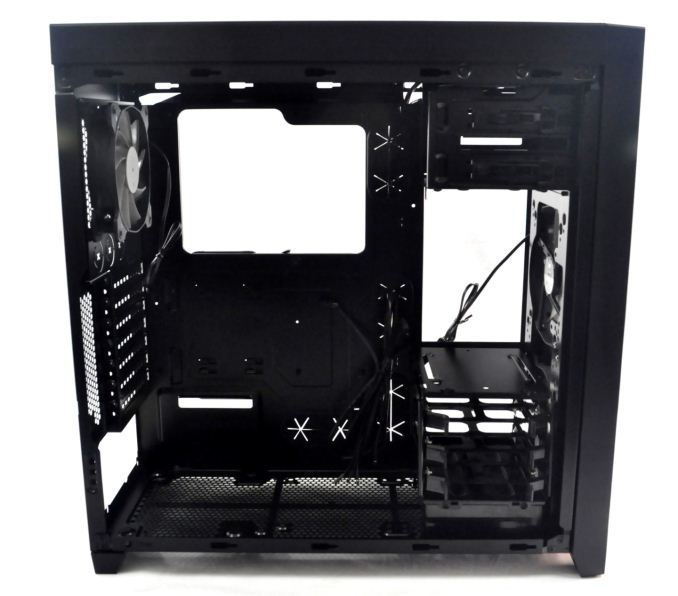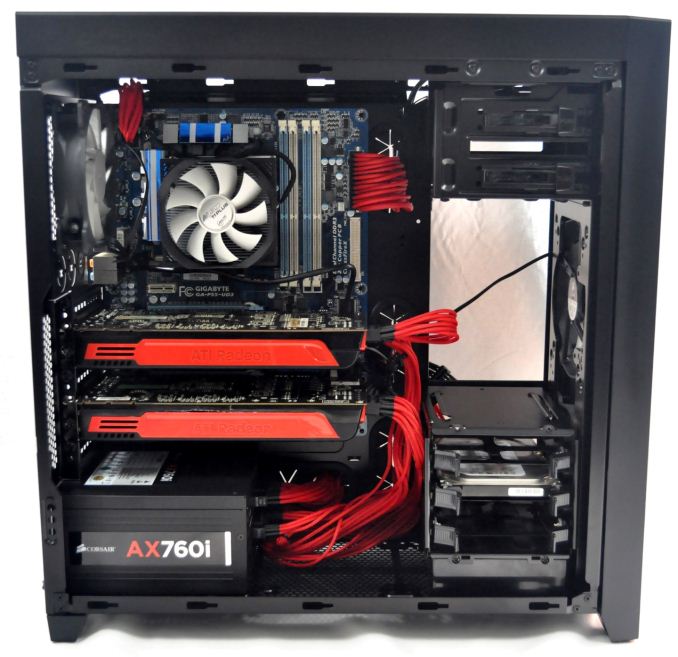Corsair Obsidian 450D Case Review
by E. Fylladitakis on April 4, 2014 6:00 AM EST- Posted in
- Cases/Cooling/PSUs
- Corsair
- mid-tower
- Case
Corsair Obsidian 450D Interior
The Obsidian 450D is entirely black and that includes every part of the interior, with the sole exception being the grey blades of the cooling fans. Mechanically, the Obsidian 450D is well designed for a case this size; most of the support depends on the motherboard tray, which is attached to the front panel via the 5.25" drive cage and a second support brace near the bottom of the case. A little flex is expected on the heavily perforated rear panel but there's nothing out of the ordinary.
The size of the motherboard tray is typical, designed to hold a full ATX motherboard. A huge opening assures the easy installation of most CPU coolers without the need to remove the motherboard from the case. Of course, smaller motherboards (Micro-ATX and Mini-ITX) can also be installed in the Obsidian 450D. Mini-ATX and narrow ATX motherboards will fit as well, but their right side will be far away from the cable hole openings and they will not cover the CPU cooler opening entirely. The clearance between the motherboard tray and the top panel is good, ensuring that liquid cooling radiators will fit; however, we strongly suggest sticking with <40mm thick radiator designs; otherwise the installation of the radiator can be obstructed by motherboard components.
It is possible to use a PSU of virtually any length with the Obsidian 450D. However, if you want to use the optional bottom intake, you need to stick with units that are 160mm long or shorter. In the case that you want to install a liquid cooling radiator there, we strongly suggest selecting a PSU that has the cable opening and/or modular connectors high up on the casing, as otherwise they might obstruct the installation of the radiator.
A single cage for up to three disk drives comes installed in the Obsidian 450D from the factory floor, with the option to add a second cage if necessary. The second cage is not included and has to be purchased separately. Each cage has three plastic trays, for the installation of an equal number of drives. Each tray can hold one 3.5" or 2.5" drive. 3.5" drives are secured by simply flexing the tray to make the metallic studs go into the screw holes of the drive, but screws are necessary for the installation of 2.5" drives. The cage itself is removable and can be installed near the bottom of the case, as pictured, or below the 5.25" drives cage. If you have plans on installing a radiator or fan at the bottom of the Obsidian 450D, the plastic frame that the drive cage sits on will have to be removed as well; this is done by removing four screws from the bottom of the case.
As is typical with all well-designed tower cases, there is ample clearance (21.3 mm from the tray to the side panel) behind the motherboard tray for the routing of cables. Corsair cleverly took advantage of that clearance and installed two additional 2.5" drive slots behind the motherboard tray. The slots are extremely easy to use; all it takes is to push a 2.5" HDD or SSD in the slot and it locks the drive into place.
Black cables and parts are easily hidden inside an all-black chassis; therefore, for visual clarity, we are using an AX760i PSU with a red cable pack and white SATA cables for our pictures. Building a system inside the Obsidian 450D is a nice experience, with most of the time required being for the routing of the cables. There are no sharp and or dangerous points about the Obsidian 450D that we could locate during our experience with it.
As exhibited in the pictures of our test build, the cables can be easily routed behind the motherboard tray and emerge from a grommet near their destination. For the CPU EPS 12V connector, Corsair positioned a small opening at the top left side of the motherboard tray. A graphics card of virtually any length can fit in the first PCI Express slot of the motherboard but it would be wise to stick with cards shorter than 260mm (10.1 in) for the other slots -- unless the drive cage is removed, in which case any card will fit. Most of the time required to build a system inside the Obsidian 450D will most likely be for the routing of the cables, which can make a bit of a mess behind the motherboard tray as there are very few cable tie mounting points. The 2.5" drive slots reduce the space available for the cables but they can be removed entirely if necessary.


















36 Comments
View All Comments
lmcd - Friday, April 4, 2014 - link
I think a reference article suggesting one generic system the test loads would be equal could help?It's tough to envision where these thermal dissipations fall in with the market.
vgray35@hotmail.com - Saturday, April 5, 2014 - link
I do not concur with your reasoning in large part. Yes comparisons are excruciatingly difficult, and in many instances possibly even impossible to construe reasonable conclusions. So what! Comparisons are not everything. Comparisons are difficult yes, but nevertheless a figure of merit in the form of a specific test case gives an idea of what the Case design is capable of achieving, quite apart from the rudimentary machinations of comparing results. We have a need for comparisons to some extent n you constant heat load idea will help here, but we also have a need for a SPECIFIC perspective on Case design. Specific test results are not invalid just because comparisons are difficult. Once I have chosen a specific Computer Case for a build, I use the specific test case as a representative example of internal case design, in terms of airflow and specific components. I am then no longer interested in comparisons.Difficulty in comparing results in no wise invalidates the usefulness of a specific test case, somehow making it useless. Measuring total heat load for a specific test case with CPU etc, temperature rises, is just that - a specific test case - that is not invalidated by some different testing methodology. It remains a real world test - just a SPECIFIC case test, comparisons aside. A single snapshot view and heat load example is not useless expressed in the form of specific components and temperature differentials.
Applying a constant heat load is a good idea as an alternative test, but you reach too far when you declare specific test cases are invalid, just because comparisons of specific test cases are difficult.They provide a figure of merit of one sort, and these are not necessarily intended to be compared with other results. Difficulty in comparisons is not a legitimate reason for abandoning specific test cases, as comparisons are not the holy grail of these results.
I like the notion that: "these specific components loaded to this specific heat load produces a specific series of temperature differentials with this specific Case and components". For example I may want to build the specific test case with only minor changes, and the impact of making the minor changes is what is of interest - not comparisons with other specific tests.
The whole gamut of your methodology intimates that "comparisons are impossible to make", and therefore specific test cases are invalid. That is wrong. Yes settings change things a lot - so just measure input power and temperatures and be done with it. Specific test cases serve much more beyond merely being used for comparison purposes, which makes them valid real world test cases.
vgray35@hotmail.com - Saturday, April 5, 2014 - link
Guess what! real work includes interacting with your client base. Reading review comments constitutes a part of your real word job.FriendlyUser - Friday, April 4, 2014 - link
Great review! I'd really like to see a similar review of the 750D one day, since I'm interested in more spacious enclosures.HisDivineOrder - Friday, April 4, 2014 - link
I wish Corsair would iterate on the 550D with a cube-shape. That'd be hot as an Obsidian product. The current Corsair cube leaves much to be desired.rpjkw11 - Friday, April 4, 2014 - link
I really like Corsair's use of magnetic dust filters, but not on the bottom as in this case. Tipping a case to remove a dust filter for cleaning is, according to Murphy's Law, an accident waiting to happen. That's nitpicking, true, but one little Ooops can ruin one's day, so for me at least, it's a deal breaker. Except for that, the 450D is a great looking, very well designed case.kmmatney - Friday, April 4, 2014 - link
You don't have to tip the case to get the bottom filter - you can use a screw driver to pop it off, or even just your fingers. Well worth it for a dust-free case.FoRealz - Friday, April 4, 2014 - link
Can you please list the weight of the cases? Many thanks!E.Fyll - Friday, April 4, 2014 - link
Yes, I will in future reviews, I just received a proper scale that was bought for that specific purpose.Subyman - Friday, April 4, 2014 - link
It seems Corsair keeps stepping down the quality of plastics they use. The front facia looks like really cheap plastic compared to their older products. This doesn't seem like a $100+ case.